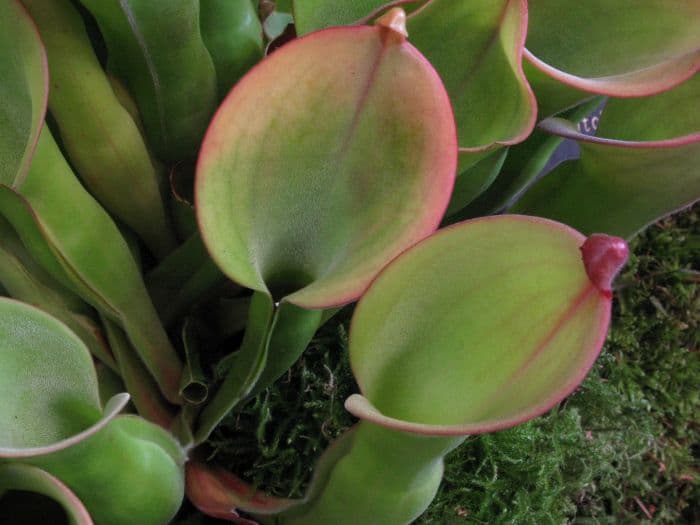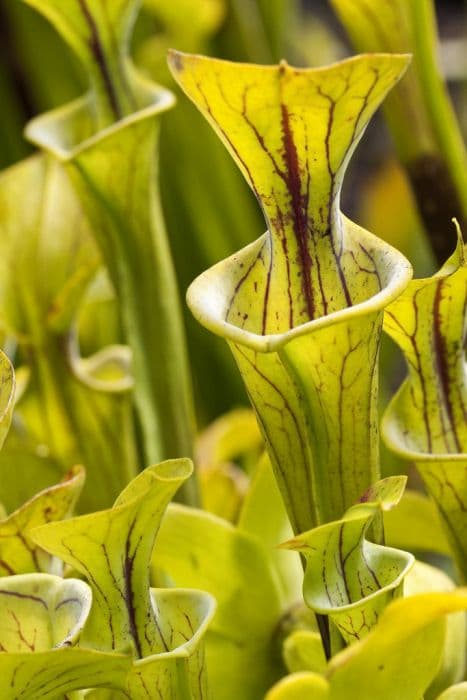Marsh Pitcher Plant Heliamphora nutans

ABOUT
The plant in question, commonly known as the Marsh Pitcher Plant, features a unique and striking appearance centered around its characteristic pitcher-like structures. These pitchers are modified leaves designed to trap and digest insects, providing the plant with essential nutrients. They are slender and elongated with a slight flare at the opening, resembling a deep cup or vase. The pitchers are often a pale green color with occasional reddish to purplish tinges, especially around the lip and inside the pitcher where the digestive fluid is present. The Marsh Pitcher Plant also sports a small, unassuming flower that stands erect on a slender stalk above the pitchers. The flower is typically a soft green or yellow-green color, with several petal-like structures that are subtly arranged. The stark contrast between the innocent look of the flower and the carnivorous nature of the pitchers below adds to the mystique of the plant. This plant can often be found with a cluster of pitchers emerging from a central point, giving it a somewhat rosette-like shape when viewed from above. The pitchers work collectively to lure and capture insects with nectar secreted by the plant. The overall appearance of the Marsh Pitcher Plant is of a delicate, yet cunning organism perfectly adapted to nutrient-poor environments where it makes the most of its ingenious strategy to supplement its diet.
About this plant
 Names
NamesFamily
Sarraceniaceae
Synonyms
Sun Pitcher, Marsh Pitcher Plant
Common names
Heliamphora nutans
 Toxicity
ToxicityTo humans
Heliamphora nutans, commonly known as the Marsh Pitcher Plant, is not considered toxic to humans. There is no well-documented evidence of toxicity in humans, and it is principally a carnivorous plant that preys on insects. Consequently, ingesting parts of the Marsh Pitcher Plant is not expected to result in poisoning or produce symptoms typically associated with plant toxicity.
To pets
The Marsh Pitcher Plant, also known to humans as the Marsh Pitcher Plant, is not known to be toxic to pets. Like in humans, there is a lack of substantial evidence supporting any toxic effects on animals. Therefore, if a pet were to ingest some part of a Marsh Pitcher Plant, it is unlikely to suffer from poisoning or exhibit symptoms that commonly occur due to ingestion of toxic plants. However, as with any non-food plant, ingestion could potentially cause mild gastrointestinal irritation or an upset stomach due to the unusual nature of the material ingested.
 Characteristics
CharacteristicsLife cycle
Perennials
Foliage type
Evergreen
Color of leaves
Green
Flower color
Red
Height
1 foot (30 cm)
Spread
1 foot (30 cm)
Plant type
Herb
Hardiness zones
8
Native area
South America
Benefits
 General Benefits
General Benefits- Educational Interest: Heliamphora nutans, commonly known as the Sun Pitcher Plant, provides an interesting subject for study due to its unique pitcher-shaped leaves and carnivorous nature.
- Conservation Value: It plays a role in conserving the biodiversity of its native habitat, the Tepui highlands in South America, by being part of a unique ecosystem.
- Horticultural Appeal: With its distinctive pitcher leaves, the Sun Pitcher Plant adds an exotic appeal to botanical gardens and collections of carnivorous plants.
- Ecological Importance: The plant participates in nutrient-poor environments by trapping insects, thus fulfilling a critical role in its ecological niche.
- Insect Control: In cultivation, Heliamphora nutans may assist in controlling insect populations by capturing and digesting small insects.
 Medical Properties
Medical PropertiesThis plant is not used for medical purposes.
 Air-purifying Qualities
Air-purifying QualitiesThis plant is not specifically known for air purifying qualities.
 Other Uses
Other Uses- Education and Research: Heliamphora nutans, commonly known as the Sun Pitcher Plant, serves as a subject in botanical studies to understand the evolution of carnivorous plants and their adaptations to nutrient-poor environments.
- Horticultural Ornament: Due to its unique shape and carnivorous nature, the Sun Pitcher Plant is grown by enthusiasts in specialized gardens or as a contained display to showcase its unusual beauty.
- Ecotourism Attraction: Habitats of the Sun Pitcher Plant can become points of interest for ecotourism, attracting visitors keen to witness these exotic plants in their natural setting.
- Photography: The striking appearance of the Sun Pitcher Plant makes it a popular subject for photographers, particularly those specializing in macro photography of plants and insects.
- Conservation Education: The plant can be used in conservation programs to highlight the importance of preserving the unique ecosystems where carnivorous plants thrive.
- Biological Pest Control: Though not utilized commercially, the Sun Pitcher Plant can theoretically help reduce the population of small insects in the immediate vicinity where it is grown.
- Art and Design: The unusual form and structure of the Sun Pitcher Plant can inspire artists and designers in creating works that mimic or are based on its natural aesthetics.
- Scientific Illustration: This plant provides an excellent subject for scientific illustrators, who play a crucial role in documenting species and educating through visual arts.
- Species Preservation: Cultivation of the Sun Pitcher Plant in botanical gardens aids in preserving the species, particularly as their natural habitats are threatened.
- Cultural Symbolism: In some cultures, unique plants like the Sun Pitcher Plant can hold symbolic meaning and be incorporated into local traditions or storytelling.
Interesting Facts
 Feng Shui
Feng ShuiThe Sun Pitcher is not used in Feng Shui practice.
 Zodiac Sign Compitability
Zodiac Sign CompitabilityThe Sun Pitcher is not used in astrology practice.
 Plant Symbolism
Plant Symbolism- Persistence: The Heliamphora, commonly known as Sun Pitcher, often symbolizes persistence due to its ability to thrive in challenging environments of its native South American Tepuis.
- Adaptation: Sun Pitcher plants have adapted to nutrient-poor soils by evolving into carnivorous plants, symbolizing the ability to adapt and make the most out of difficult situations.
- Uniqueness: Sun Pitchers are unique in their appearance and hunting mechanism, representing the uniqueness and individuality in nature or within a person.
- Patience: As a carnivorous plant, the Sun Pitcher must wait patiently for its prey, hence it symbolizes patience and the virtue of waiting for the right moment.
- Attraction: Sun Pitchers attract insects not only with their nectar but also with their appearance, representing allure and the power of attraction.
 Water
WaterSun pitchers, the common name for Heliamphora nutans, should be watered thoroughly but infrequently, allowing the growing medium to remain moist but not waterlogged. They thrive in high humidity environments and prefer rainwater or distilled water. It is ideal to maintain a consistent watering schedule, typically watering once every 5 to 7 days, depending on the humidity and temperature of the growing environment. Adjust the frequency of watering during hotter, drier periods to every 3 to 4 days. As a guideline, using approximately 16 to 24 ounces of water every week should suffice, but always adjust according to the plant's response and the current growing conditions.
 Light
LightSun pitchers prefer bright, indirect light or diffused sunlight. A spot that receives dappled light or a location with a sheer curtain to filter direct sunlight is ideal. They can endure short periods of direct morning sun but should be shielded from harsh, direct afternoon light to prevent leaf burn.
 Temperature
TemperatureThe sun pitcher plant thrives in a temperature range from 70 to 80 degrees Fahrenheit during the day and cooler night temperatures, ideally between 50 and 60 degrees Fahrenheit. It can survive temporary dips down to 40 degrees Fahrenheit, but exposure to temperatures below this can be detrimental. The ideal temperature range is crucial for their successful growth and pitcher formation.
 Pruning
PruningPruning sun pitchers is primarily focused on removing dead or decaying pitchers and leaves to maintain plant health and aesthetics. Prune as needed, which is typically once the pitchers have died back or become brown. The best time for pruning is in the late winter or early spring before new growth emerges.
 Cleaning
CleaningAs needed
 Soil
SoilSun Pitcher plants require acidic soil with good drainage, ideally with a pH around 4 to 6. A recommended soil mix for Sun Pitchers consists of a mixture of peat moss, perlite, and sand in equal ratios, avoiding any lime or fertilizer additions to maintain acidity and purity.
 Repotting
RepottingSun Pitchers generally need to be repotted every 2 to 3 years, or when they outgrow their current pot. It's important to use fresh, suitable soil mix during repotting to maintain health.
 Humidity & Misting
Humidity & MistingSun Pitchers thrive in high humidity conditions, ideally between 60% to 80%. Consistently high humidity is crucial for the plant's growth and pitcher development.
 Suitable locations
Suitable locationsIndoor
Grow in bright light with high humidity and cool temps.
Outdoor
Use cool, humid spots with bright, diffuse light.
Hardiness zone
10-11 USDA
 Life cycle
Life cycleThe Sun Pitcher Plant (Heliamphora nutans) begins its life cycle from a small, black seed which, under appropriate moist and cool conditions, germinates to give rise to a tiny plantlet. The seedling develops a rosette of pitcher-shaped leaves adapted for trapping and digesting insects, a crucial adaptation for nutrient acquisition in its nutrient-poor native habitat. As the Sun Pitcher Plant matures, it produces more pitchers and can eventually form clumps with multiple rosettes. It reaches reproductive maturity after several years, whereupon it sends up a tall flower stalk bearing a few large, nodding flowers that are typically red or pink and pollinated by insects. After pollination, the flowers produce seeds that are distributed by wind, thus completing the plant's reproductive cycle. The adult plant continues to grow and can live for many years, periodically flowering and setting seed when conditions are favourable.
 Propogation
PropogationPropogation time
Spring-Early Summer
Heliamphora nutans, commonly known as the Sun Pitcher Plant, is typically propagated through the division of mature plants. The ideal time to propagate is during the spring, when the plant is emerging from its winter dormancy and beginning its active growing phase. To propagate by division, the grower carefully removes the plant from its pot and gently separates the rhizomes, ensuring that each division has at least one growth point. After division, the individual clumps are potted in a well-draining, acidic medium suitable for carnivorous plants, such as a mix of peat and perlite. The new pots are then placed in a humid environment with bright, indirect light to encourage growth. Roots usually establish within a few weeks, and special care should be taken to maintain the high humidity that Sun Pitcher Plants require.




